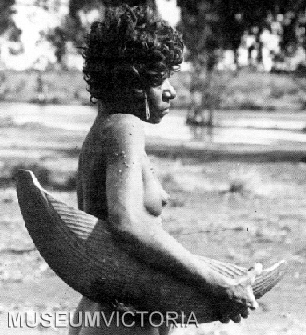Kaititja Woman Pitchi

The leaves of many plants found in this arid region have adapted to the climate by becoming either very thin, as in the acacias and desert oaks (Casuarina Sp.) or thick and succulent like the Portulaca and Claytonia species. Claytonia, growing in low clumps on the ground, form a valuable food source for Central Australian Aborigines, especially important during the dry season when other plants cannot survive. The leaves and stalks are eaten but much more valuable are the small black and brown seeds (Munyeru and Parakilia) produced by these plants.
Spencer describes the common scene of women returning to their camps in the evening,
each of them carrying on one hip her youngest child, and on her head a pitchi of Munyeru, which she has spent the whole day in collecting and patiently winnowing to free it from the husks.
The winnowing process relies on the seasonal winds from the south-east blowing away the husks as the seeds are poured between two pitchis. After being winnowed the seeds are ground into powder by means of flat, oval-shaped grindstones which, because of their weight, are usually left in the camps. These grindstones are evidently used for very long periods of time, and, as they are met with in many parts of the country where such slabs of stone are not procurable, they must often be traded over long distances. When grinding seed a woman sits in front of this large stone and, pouring seeds into a well worn concavity on its surface, begins grinding the seeds with a smaller rounded stone held in one hand. As the smaller stone is moved back and forth, small amounts of water are added to the seeds to form, eventually, a dark paste. This paste can be eaten or formed into a small cake and cooked in hot ashes. Spencer recognised that the sand content of these cakes contributed greatly to the worn state of adult teeth.
Spencer describes the common scene of women returning to their camps in the evening,
each of them carrying on one hip her youngest child, and on her head a pitchi of Munyeru, which she has spent the whole day in collecting and patiently winnowing to free it from the husks.
The winnowing process relies on the seasonal winds from the south-east blowing away the husks as the seeds are poured between two pitchis. After being winnowed the seeds are ground into powder by means of flat, oval-shaped grindstones which, because of their weight, are usually left in the camps. These grindstones are evidently used for very long periods of time, and, as they are met with in many parts of the country where such slabs of stone are not procurable, they must often be traded over long distances. When grinding seed a woman sits in front of this large stone and, pouring seeds into a well worn concavity on its surface, begins grinding the seeds with a smaller rounded stone held in one hand. As the smaller stone is moved back and forth, small amounts of water are added to the seeds to form, eventually, a dark paste. This paste can be eaten or formed into a small cake and cooked in hot ashes. Spencer recognised that the sand content of these cakes contributed greatly to the worn state of adult teeth.
Keywords: aborigines, anthropology, custom, 1901
Photograph: Kaytetye woman carrying a pitchi. She is wearing euro bone ear ornaments. Barrow Creek, July 1901. Photograph Baldwin Spencer. Reproduced courtesy Museum Victoria.
Author: Rowse, Tim and Graham, Trevor
Author: Rowse, Tim and Graham, Trevor
